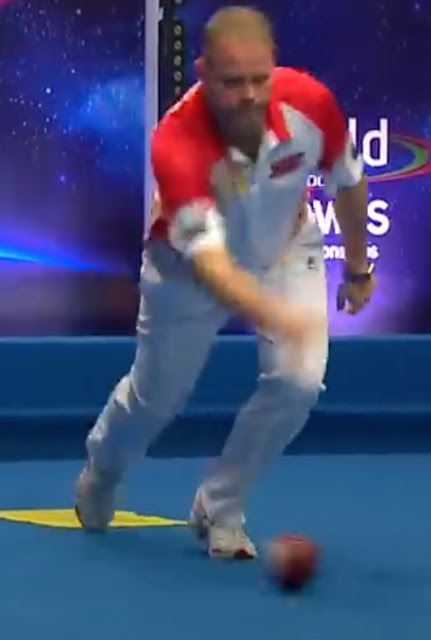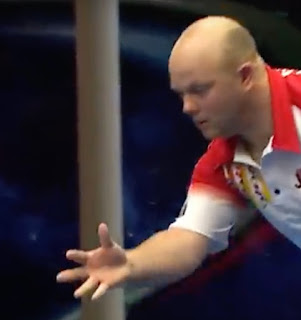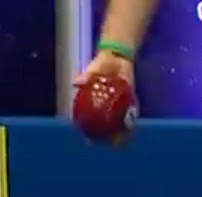After the 2019 World Indoor Bowls Championship, Robert Paxton, who lost in the Mens Singles Final to Nicky Brett, was ranked third in the world. It is interesting for bowling enthusiasts to examine his delivery.
Robert Paxton bowls from a stance with both feet parallel and almost side by side on the mat. The foot that he will advance is one-half a shoe length forward of his anchor foot. This is close to the classic feet-together position. Most often both feet are close to completely on the mat. The modern teaching is that only the anchor foot need to be on the mat. Center-line bowlers are taught to deliver both forehand and backhand over the front center of the mat. Another recent teaching is to have the foot that is going to step forward into the shot, slightly advanced. This style was first observed among South African bowlers but is now common throughout the world. Another option very common today is the Shooters’ Stance, popularized on-line by New Rodda from Australia. In point of fact, the author of Greenbowler has adopted the Shooters’ Stance himself.
To identify Robert Paxton’s grip you need to run Youtube video at the slowest speed (1/4 of normal) and stop the frames when he is adjusting his grip. Paxton bowls using a grip halfway between the claw grip and what is called the gyrostatic grip.
I could find no reference to the gyrostatic grip on Google however it is taught by a booklet called The Lawn Bowler’s Manual written by Len Hyde of the Zone 9 Association of Coaches in New South Wales Australia. This grip is designed to allow the hand and forearm to remain in their normal positions, without needing to turn the hand over, as in the case with the other grips. The palm and fingers are located at the side of the bowl with the thumb on top. The gyrostatic grip may be useful for club bowlers who have very short thumbs or arthritis. Such people might model their deliveries after Robert Paxton.
In Robert’s grip, instead of his hand gripping the bowl from the side, an extension of the line of his wrist intersects the plane of the running surface of his bowl at about 45 degrees.
Although Paxton’s overall delivery is speedy, the amount of time he takes confirming that his finger positions are precise is longer than for most. This is because, being a gyrostatic/claw bowler, the bowl does indeed roll off his fingers and hence they need to be precisely positioned.
For a reason that is not obvious Paxton tilts the upper part of his bowl towards his body in the ready position.
Paxton’s Opposite Hand Position
The ‘opposite hand’ refers to the hand that does not do the bowling. This hand in the cases of most bowlers participate very little in their deliveries. Robert Paxton has a very peculiar action of his free hand. At the ready position; just before starting his delivery action, he has his hand on his thigh a few inches above the knee. An instant before he starts to move, he hitches up his pants with the fingers of this hand in a sort of scratching motion and then as he starts his delivery action he slides this hand down and cups his knee with that hand. This action is probably done to loosen his pant leg so that he can stride forward without hindrance. Amusingly he retains the action even when he is wearing short pants!
Paxton’s Back-Swing
Robert Paxton has essentially no backswing. His draw uses the exact technique of the ‘running shot.’ Greenbowler has completed blog articles covering the running shot and comparing it with the yard-on and drive shots. For clarity, I will quote the pertinent part from one of those articles:
“The delivery of the running shot begins with the delivery arm holding the bowl hanging vertical and the body bent from the waist to bring the bowl close to the ground. Some players use a little backswing for this shot but no backswing is preferred. “
Well, Robert Paxton uses the running shot delivery for regular draw shots and drives by adjusting to an appropriate weight.
Because he has essentially no backswing he moves his whole body quickly forward with a large forward step.
Although Paxton is not a palm bowler, his delivery is an option for palm bowlers. Since there is no backswing the bowl cannot fall out of the hand. The other option for palm bowlers is Nicky Brett’s delivery that makes use of the Bryant twist to retain the bowl during a backswing.
Forward Stepping
Robert’s entire body moves forward with his bowl swing. His forward stepping foot first contacts the bowling surface heel first and then he rocks forward onto his toes. The illustration below shows him on the toes of his advancing foot with his arm outstretched following the bowl. His eyes are still staring at his aim point.
That the knee of his anchor foot bends in behind the heel of his stepping foot is best seen in the left-most picture under backswing. People often wonder why this is done. The reason can be understood from the slow-motion delivery.
Following Through
In the follow-through Paxton's wrist remains locked straight and there is no flicking of his fingers.
Walking Off the Mat
Paxton doesn’t walk off the mat to the same extent as other top bowlers. Because he stays so low and his forward step is so long he is not in position at the end of his follow-through to walk normally.
Positioning on the Mat
Robert Paxton can be seen to change his set-up position on the mat to help get around bowls or to be sure that he gets back to center rink .










































